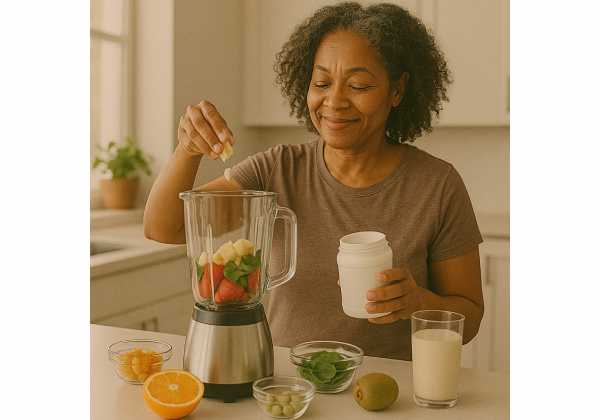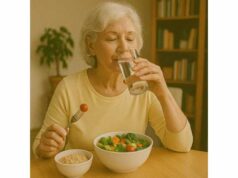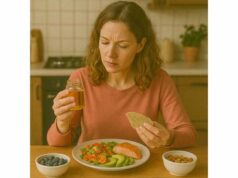
Collagen gives structure to skin, cartilage, tendons, bone, and the gut. As we age, we remodel collagen more slowly and tolerate stress less easily, which can show up as fine lines, joint stiffness, or longer recovery after activity. Food can’t freeze time, but it can supply the raw materials and cofactors your cells need to keep building and repairing. This guide shows how vitamin C, glycine, and proline work together; which foods and preparations deliver them; and how to pair collagen precursors with daily protein and movement. You will also learn cooking methods that preserve delicate nutrients, simple meal ideas that fit busy weeks, and when a “food first” approach is enough. For pattern-level advice that pairs with collagen support, see our broader primer on longevity-focused nutrition principles.
Table of Contents
- Collagen Synthesis 101 and Why Vitamin C, Glycine, and Proline Matter
- Top Food Sources: Meat Cuts, Fish Skin, Gelatin, and Plant Contributions
- Pairing with Protein and Leucine to Support Skin, Joints, and Tendons
- Cooking and Preparation Tips to Preserve Vitamin C and Collagen Precursors
- Sample Meals and Snacks That Support Collagen Turnover
- Who May Benefit Most and When Food First Is Enough
- Safety, Tolerability, and Smart Use with Existing Conditions
Collagen Synthesis 101 and Why Vitamin C, Glycine, and Proline Matter
Collagen is a family of proteins built from three chains wound into a triple helix. Each chain follows a repeating pattern—commonly glycine–X–Y—where X and Y are often proline or hydroxyproline. This design gives collagen its tensile strength in tendons, its stretch–recoil in skin, and its scaffolding role in bone and blood vessels.
The assembly line in plain language
- Cells produce procollagen chains from amino acids. Glycine fits at every third position—the helix won’t form without it. Proline helps stabilize the structure, and many proline residues are later hydroxylated to hydroxyproline, which strengthens cross-linking.
- Vitamin C (ascorbate) is the indispensable cofactor for prolyl and lysyl hydroxylases—enzymes that add hydroxyl groups to proline and lysine. Without vitamin C, hydroxylation stalls and new collagen is weak or fails to assemble.
- Enzymes trim, fold, and cross-link the fibers. Final collagen bundles then integrate into skin, cartilage, ligaments, bone matrix, and the gut’s connective tissue.
Why aging shifts the balance
- We synthesize new collagen more slowly and accumulate more cross-links from oxidative stress and glycation. That can make tissues stiffer and less resilient.
- Estrogen decline reduces collagen content in skin and tendons; inactivity further lowers collagen turnover.
- Diet patterns low in vitamin C and total protein starve the process of basic inputs, while ultra-high heat cooking adds advanced glycation end products (AGEs) that may stiffen tissues over time.
What nutrition can do
- Supply vitamin C daily—the body does not store much—so that every new collagen molecule can mature correctly.
- Provide glycine and proline through whole-protein foods and collagen-rich parts of animals (skin, bones, connective tissue) or through plant meals that contribute glycine precursors.
- Pair collagen precursors with leucine-rich protein and movement so new collagen is laid down where it’s needed (tendons, fascia, skin) and integrated into stronger tissue.
Practical bottom line: A collagen-supportive plate isn’t exotic. It’s regular produce for vitamin C, adequate total protein, and a few meals each week that include collagen-rich foods—set in a lifestyle that includes resistance training and walking.
Top Food Sources: Meat Cuts, Fish Skin, Gelatin, and Plant Contributions
You can feed collagen synthesis from many directions. Some foods deliver the exact building blocks (gelatin, bone broth, fish skin). Others provide complete protein that includes glycine and proline alongside leucine. Plant foods add vitamin C and amino acid precursors plus polyphenols that may reduce oxidative cross-linking.
Animal-based options
- Gelatin and collagen peptides: Derived from animal connective tissue; rich in glycine and proline/hydroxyproline. Collagen peptides dissolve in hot or cold liquids and have neutral flavor, making them easy to add to yogurt, oats, or soups.
- Fish skin and scales: Crispy salmon skin, sardines with skin and bones, and traditional fish soups supply collagen peptides, minerals, and omega-3 fats.
- Bone-in and connective tissue cuts: Shank, oxtail, chuck roast, and chicken drumsticks or wings—when slow-cooked—release gelatin into the cooking liquid. Chill the broth and you’ll see a natural “gel” that signals collagen content.
- Eggs and dairy: Not collagen-rich, but they provide complete protein plus vitamin A and minerals that support tissue repair.
Plant-based contributions
- Vitamin C carriers: Kiwi, citrus, strawberries, bell peppers, broccoli, Brussels sprouts, tomatoes, and leafy greens. Just 1 cup of strawberries or a medium bell pepper can cover a large share of daily vitamin C.
- Glycine precursors and supportive amino acids: Soy foods (tofu, tempeh), legumes, quinoa, and nuts contribute overall protein and small amounts of glycine. While plants don’t contain collagen, a varied plant-protein pattern still supplies what your body needs to build it—especially when total protein is adequate.
- Polyphenol-rich foods: Berries, cocoa, green tea, and colorful vegetables may help counter oxidative stress that otherwise stiffens collagen. For a broader tour of these foods, see our quick guide to polyphenol-rich choices.
Bone broth realities
Bone broth can be a helpful vehicle for gelatin and minerals, but its protein content varies widely (often 5–10 g per cup unless concentrated). Treat it like a supportive base rather than a standalone protein source. If you want guaranteed intake of collagen-specific amino acids, collagen peptides offer predictable dosing.
Smart budget strategies
Canned salmon or sardines (with skin and bones), chicken thighs, and dried beans are affordable staples. Save braising liquids and roast drippings to enrich soups and grains; when cooled, the natural gel indicates useful collagen fragments.
One link to remember
If you’re optimizing fats and lipids while you add collagen-rich dishes, pair them with a pattern that emphasizes olive oil, nuts, and fish. For practical swaps that favor long-term heart health, skim healthy fat choices.
Pairing with Protein and Leucine to Support Skin, Joints, and Tendons
Collagen peptides supply the right bricks, but you still need foremen and cranes to build. That means adequate total protein, leucine-rich pulses to stimulate muscle and tendon remodeling, and movement to tell your body where to lay new material.
Hit daily protein, then time the pulses
- Daily range: Many active older adults do well with 1.0–1.6 g protein/kg/day, scaled to health status and goals.
- Per-meal target: Aim for 0.25–0.40 g/kg (about 25–40 g for most adults) at breakfast, lunch, and dinner to cross the “leucine threshold” and turn on tissue-building pathways.
- Collagen’s role: Collagen proteins are low in leucine and tryptophan, so treat them as add-ons, not replacements for complete proteins. For example, add 10–20 g collagen peptides to breakfast plus eggs or yogurt, or stir 10 g into a post-walk cocoa alongside soy milk or whey.
Why leucine and movement matter
Leucine triggers mTORC1 signaling for muscle protein synthesis, which indirectly supports tendon and fascial remodeling by increasing mechanical load tolerance. Movement—especially resistance training, eccentric exercises, and brisk walking—provides the signal for collagen turnover in tendons and ligaments. The combination of mechanical load + amino acids + vitamin C is more effective than any one input alone.
Skin support
Skin’s dermis relies on type I collagen intertwined with elastin and hydrated by glycosaminoglycans (e.g., hyaluronic acid). Adequate vitamin C, total protein, and omega-3 fats support dermal structure and barrier function. Hydration and sun protection protect new collagen from breakdown—no nutrient offsets chronic UV exposure.
Tendon and joint routines (food + activity)
- Pre-load: 30–60 minutes before rehab or a walk, take 10–15 g gelatin or collagen peptides with vitamin C-rich food (e.g., gelatin gummy made with orange juice, or collagen in yogurt with kiwi).
- Load: Do 10–15 minutes of tendon-targeted movements (e.g., heel drops for Achilles, slow eccentrics for patellar or elbow tendons).
- Repeat: Two to three times per day during dedicated rehab phases, or 4–6 days per week during maintenance.
For more on per-meal protein pacing and how to adapt it by age and activity, see our guide to even protein distribution.
Cooking and Preparation Tips to Preserve Vitamin C and Collagen Precursors
Vitamin C is water-soluble and heat-sensitive. Collagen precursors (gelatin, hydrolyzed collagen) are heat-stable in everyday cooking, but delicate antioxidants in fruits and vegetables can degrade with high heat, long times, and lots of water. The goal is not raw at all costs; it’s smart prep that balances safety, flavor, and nutrient retention.
Keep vitamin C on the plate
- Use quick heat: Stir-fry, microwave, or steam vegetables until just tender-crisp (3–7 minutes depending on the veg).
- Mind the water: When boiling potatoes or greens, cook in minimal water and reuse the cooking liquid in soups or sauces; vitamin C leaches into water.
- Cut right before cooking: Less surface area and less time exposed to air slow oxidation.
- Add raw accents: Finish hot dishes with fresh lemon juice, diced peppers, tomatoes, or herbs for a vitamin C boost without extra cook time.
Respect the collagen
- Low-and-slow for tough cuts: Braise shanks or chuck at low simmer; pressure cookers reduce time while extracting gelatin into the broth. Chill and skim excess fat if needed; keep the jiggly gel—it’s the good part.
- Don’t fear reheating: Gelatin melts with heat; that’s normal. Collagen peptides in oatmeal, soups, or sauces tolerate typical reheating.
- Broth concentration: If your broth doesn’t gel, simmer uncovered to reduce; taste and season at the end.
Limit unnecessary AGEs
- Moist heat beats high dry heat: Frequent charring and deep frying add advanced glycation end products that can stiffen tissues over time. Enjoy grilled foods, but balance with stews, soups, and poached or baked options.
- Marinate smart: Acidic marinades (citrus, vinegar) and herbs reduce surface AGEs and add flavor.
Food safety matters
Cook meats to safe internal temperatures and chill leftovers promptly. Vitamin C-rich fruits and vegetables are typically eaten raw—wash thoroughly and handle with clean utensils to avoid cross-contamination.
For a wider tour of gentler cooking methods that support long-term health, see our practical look at cooking methods that go easier on tissues.
Sample Meals and Snacks That Support Collagen Turnover
Use these mix-and-match templates to cover vitamin C, collagen precursors, and complete protein across the day. Adjust portions to your energy needs.
Breakfasts
- Citrus yogurt bowl: Greek yogurt (25–30 g protein) with orange segments, strawberries, chopped pistachios, and 10 g collagen peptides stirred in.
- Tofu–potato skillet: Tofu scramble with diced bell peppers, baby potatoes, and spinach; finish with lemon zest.
- Oatmeal plus: Rolled oats cooked in milk; stir in whey or soy protein and collagen peptides; top with kiwifruit and cocoa nibs.
Lunches
- Salmon skin rice bowl: Crisp salmon skin, steamed rice, edamame, cucumbers, and nori; splash of citrus-soy dressing.
- Chicken and pepper grain salad: Roast chicken thighs, farro, roasted red peppers, arugula, and herbs.
- Tempeh rainbow wrap: Tempeh, shredded cabbage, bell peppers, avocado, and citrus yogurt sauce in a whole-grain wrap.
Dinners
- Braise night: Beef shank or oxtail simmered with carrots, onions, and tomatoes; serve with polenta and a side of garlicky greens.
- Mediterranean fish stew: White fish, tomatoes, fennel, and potatoes in a lemon-herb broth; add a handful of chopped parsley just before serving.
- Chicken soup upgrade: Whole chicken simmered with celery and carrots; chill and remove excess fat; rewarm and finish with dill and lemon juice.
Snacks and small bites
- Gelatin–C gummies: Homemade gelatin squares set with orange or acerola juice (for vitamin C).
- Cottage cheese with berries: Add lemon zest for a citrus lift.
- Bone broth latte: Warm concentrated broth whisked with a touch of miso; pair with a small sandwich for complete protein.
Weekly rhythm ideas
- Aim for two “collagen-forward” meals per week (e.g., braise or fish skin) and one vitamin C–packed salad or bowl daily.
- Layer protein pulses at each meal (25–40 g), and use 10–15 g collagen before tendon rehab or a brisk walk, paired with fruit.
- Batch-cook: braise on Sunday; portion gelatin-rich broth into ice-cube trays to enrich grains and sauces all week.
For help assembling meals quickly without sacrificing nutrient balance, check our tips on batch cooking and freezer staples.
Who May Benefit Most and When Food First Is Enough
Most healthy adults can meet collagen-supportive needs with food first: daily vitamin C from fruits and vegetables; complete proteins spaced across meals; and a couple of collagen-rich dishes each week. Certain groups may benefit from extra attention—or a short, targeted trial of collagen peptides.
Groups to prioritize
- Adults 50+: Slower collagen turnover and reduced skin elasticity make steady input helpful. Pair higher-protein meals with resistance training and daily walking.
- Athletes and return-to-play rehab: Repetitive tendon loading (running, court sports, strength training) increases remodeling demands. The gelatin/collagen + vitamin C + load protocol can be a practical add-on.
- Postmenopausal women: Estrogen decline reduces collagen content in skin and connective tissue. Combined strategies—protein pacing, vitamin C intake, resistance training—carry more weight than any single tool.
- Low-intake eaters: People with low appetite, small breakfasts, or limited cooking time may under-consume protein and vitamin C; easy add-ins (collagen peptides, yogurt, canned fish, frozen berries) can close gaps.
- After weight loss or illness: Recovery phases often require higher protein and vitamin C to rebuild tissue integrity.
When “food first” is likely enough
- You regularly eat 2+ cups of produce daily (including vitamin C-rich fruit/veg), hit protein at each meal, and include some connective-tissue foods weekly.
- Your skin, nails, and recovery feel stable, and you’re training consistently without tendon niggles.
- Your budget or preferences favor whole foods; collagen peptides aren’t mandatory.
When a supplement trial makes sense
- You want a structured 6–12 week experiment during rehab or higher training loads. Try 10–15 g collagen peptides once or twice daily, with at least one dose 30–60 minutes before loading, alongside vitamin C-rich food.
- You struggle to eat enough protein at breakfast; adding 10 g collagen to a yogurt bowl or oats can raise the total—not as the sole protein, but as a booster.
For joint-friendly, lower-inflammation meal swaps that complement a collagen plan, browse practical ideas for simpler anti-inflammatory choices.
Safety, Tolerability, and Smart Use with Existing Conditions
Collagen-supportive eating is safe for most people, but a few considerations help you personalize the plan.
Digestive comfort
- Gelatin vs peptides: Some people feel fuller or experience mild bloating with gelatin; hydrolyzed collagen peptides are usually gentler. Start with 5–10 g and build up.
- Bone broth: Histamine levels can rise with long simmers, especially if broth sits warm before chilling. If you’re histamine-sensitive, use pressure cookers, quick chill, and freeze portions.
Allergies and dietary preferences
- Choose bovine, porcine, marine, or certified-allergen-controlled collagen if you use supplements. If you avoid animal products, focus on plant proteins, vitamin C-rich produce, and gentle cooking methods; collagen synthesis still proceeds with adequate amino acids and micronutrients.
Kidney stones and protein
- Higher protein can increase urinary calcium in some individuals. Balance protein across meals, hydrate well, and include potassium-rich produce. If you have a stone history, follow your clinician’s guidance.
Lipids and sodium
- Collagen powders are low in fat and sodium, but broths and processed soups can be salty. Taste before salting; choose lower-sodium bases; balance dishes with potassium-rich vegetables.
Medications and special conditions
- Anticoagulants: Large, rapid changes in vitamin K are uncommon with collagen-forward eating, but if you increase leafy greens for vitamin C, maintain consistent portions and inform your clinician.
- Diabetes and glucose monitoring: Collagen powders typically contain minimal carbohydrate. Pair vitamin C-rich fruit with protein to soften glucose rises.
- Gout: Gelatin and meat stocks contain purines; if you have gout, keep portions moderate, hydrate, and prioritize fish and plant proteins within your plan.
- Reflux: Rich, fatty braises close to bedtime may worsen symptoms. Cook earlier, skim fat, and keep dinners moderate. For more tactics, see tips to reduce reflux triggers.
Quality checks for supplements (if used)
- Look for third-party testing (e.g., for heavy metals and microbiological safety).
- Choose single-ingredient powders without unnecessary sweeteners or fillers.
- Expect neutral flavor and full dissolution in hot liquids; a mild texture in cold liquids is normal.
Synthesis you can use tomorrow
- Plate vitamin C at least twice daily (fruit or veg).
- Hit 25–40 g protein per meal; layer 10–15 g collagen before tendon-focused loading if you’re rehabbing.
- Cook low-and-slow sometimes; add raw or lightly cooked produce often; walk and lift regularly. Small inputs, repeated, drive the big outcomes.
Disclaimer
This guide is educational and not a substitute for personalized medical advice. Nutrient needs and tolerances vary with health status, medications, and goals. If you have chronic illness, are pregnant, or manage conditions like kidney disease, gout, or reflux, consult a qualified clinician or registered dietitian before making significant changes to your diet or starting collagen supplements.
If this article helped you, please consider sharing it on Facebook, X (formerly Twitter), or your preferred platform, and follow us for future updates. Your support helps us continue creating practical, evidence-based content.










